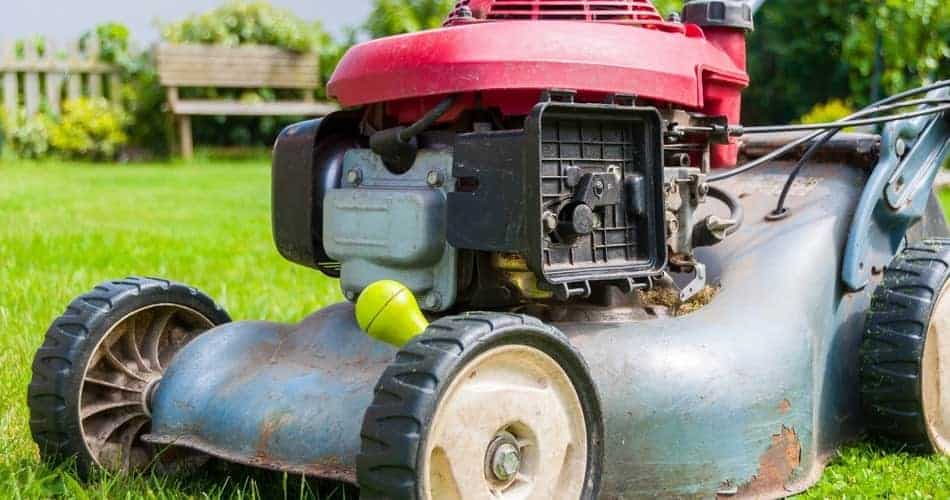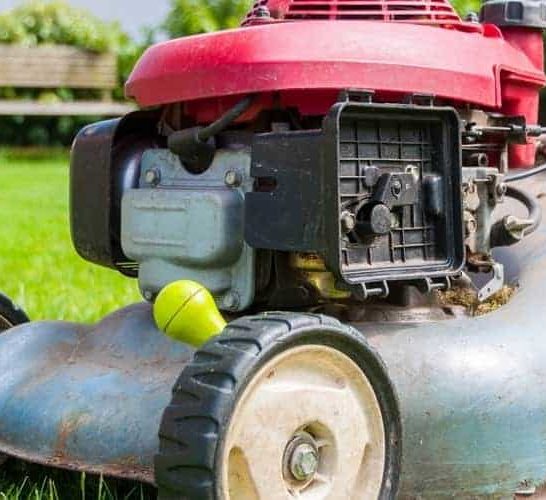You’re hoping to find a great deal on a used mower instead of paying the top price to purchase a new one. It’s exciting when you can find a used mower at a great price, but you don’t want to regret your purchase later.
I’m sure you have traveled down the back roads or in and out of different neighborhoods and noticed that one house that always has something used for sale in its yard.
Sometimes it’s a car, boat, lawn mower, weed whips, or something else. There’s always something there. When you see a lawn mower it may catch your eye so let’s go over what you should look for when you see these front yard gems.

This post may include affiliate links. Purchases made through these links may provide a commission for us, at no extra cost to you. As an Amazon Associate, we earn from qualifying purchases.
Follow all safety instructions provided in your equipment operator’s manual prior to diagnosing, repairing, or operating.Consult a professional if you don’t have the skills, or knowledge or are not in the condition to perform the repair safely.
What to Watch Out for When Buying a Used Mower
1. Damaged Appearance & Signs of Lawn Mower Age
Does the mower look in good condition and like it was well taken care of? Has anyone welded up the deck, handlebars, or any other area of the lawn mower? Check to see if there is paint rubbing off from being used under bushes and trees.
Do you notice any physical damage? The paint isn’t a big issue, but it does say a lot about the care of the unit. Has it sat outside all winter for the last couple of years? Sometimes it’s the little things like paint that can point to the mower not being well cared for.
Look at the wheels next and make sure they are nice and straight. Is the tread worn off of the tires? This wear factor can give you a clue about age. If the wheels appear all beat up and kind of crooked the mower has had some rough encounters with objects.
2. Bad Throttle Cable and Linkage on Lawn Mower
Check the choke lever, throttle linkage, and cable. If the throttle cable doesn’t move, the linkages may be stuck due to rust.
You may be able to lubricate and get the linkages to move if nothing is broken, but sometimes they are too rusted from sitting outside in the elements and are beyond being fixed by lubricating.
If you find broken a linkage, spring, or throttle cable, you will have to get these repaired.
3. Listen to Seller’s Explanations of Lawn Mower History
Ask the seller if he is the original owner. If the individual repairs and sells equipment he or she may say it’s a family member’s or friend’s mower. This is what I often hear when stopping at one of these places.
Often the seller can play kind of dumb on some of the answers if the mower is being sold on behalf of someone else. There is a chance that this is true, but it always puts me on high alert when I get this answer after asking the question.
Ask the seller if the mower is used in the seller’s yard. If the answer is yes, take a look over the condition of the yard and see if there’s any indication why the mower is in the condition it is in that may throw up a red flag.
Look over how well the yard is maintained and how the mower cuts. Ask the owner why a new mower is being purchased.
4. Lawn Mower Engine Oil Consumption
Check the engine oil. I like to do this with the seller there to hear the answer when I ask him if the engine burns or consumes oil. If you notice the engine oil level is lower than recommended you may already have the answer to your question.
Just because the oil level is down doesn’t necessarily mean the engine is consuming oil, but it is low and there should be an explanation. Engine damage can occur if the engine oil isn’t changed regularly.
5. Hard Starting Lawn Mower & Engine Noise
Ask the owner to start the mower or try to start it yourself. If it is a pull-type starter, see how many pulls it takes. If the seller adds a touch of gas to the carburetor to get it started and it runs great. The lawn mower could have a carburetor issue or valve problem.
Let the engine run and warm up to see if it begins to smoke out of the muffler. This again will give us a little information on the engine.
Listen for a knock or a rattle in the engine that may tell us if there are internal engine issues. Smoke can tell you if you may have engine problems. Read 5 different issues that can cause your lawn mower to smoke.
6. Damaged Mower Deck, Cutter Housings & Spindles
When you are satisfied with the way the engine runs, shut it off, and disconnect the spark plug. Wait for all of the moving parts to stop and look under the mowing deck to see what the blades look like.
If the blade is bent, loose, or has chips it will have to be replaced. I wrote a more in-depth post here to help you identify significant deck problems.
The lawn mower deck may be plugged with grass, this isn’t a bad thing, it just tells you that it was not a well-maintained mower or they didn’t have time to clean it before selling it.
7. Bad Belts on Self Propelled, Riding & Zero Turn Mowers
The belts are fairly easy to check. Read more about belts with these two articles: “This is Why Your Belt Keeps Falling Off Your Mower” and “How Long a Mower Drive Belt Should Last“.
Mower Deck Belt
Check the mower deck for cracking. Move the belt by hand to make sure the pulleys are moving smoothly and are not damaged or have a bearing that needs to be replaced.
Transmission Belt
If the mower has a transmission you will want to inspect it. There are often a few different types of transmission on lawn mowers. There are gear and hydrostatic transmissions. You will find a transmission belt that powers a gearbox or a hydro drive mower.
8. A Weak Lawn Mower Transmission
- If the mower is front-wheel drive, start the mower, pull back on the handles and pick up the front end. Engage the drive and slowly lower the front end to the ground and check to see if, while applying pressure to the wheels, the wheels may stop or hesitate to drive.
Bearing a bit of a load may let you see if the wheels will stop driving. If it does stop, you may have an issue with the gearbox.
- What if the mower is hydro drive? You will go through similar procedures as you did with the front drive system, but you will not be able to lift the mower to test this. Instead, park it up against something solid like a tree or post. (Try not to damage anything or the seller may force you to buy the mower).
Rev the engine up, bring it close to the solid object, and slowly go forward to se3 if you can make the wheels spin. If they spin, chances are the hydro is building pressure in the pump and the drive is okay.
How to Buy a Lawn Mower at an Auction
You can find some fantastic deals at an auction, but you need to beware of what you are buying especially if you are buying online and don’t have a chance to look at the lawn mower in person.
I have seen many lawn mowers in my repair shop that have been purchased at an auction. While I have seen homeowners with great finds, I also know homeowners who had to invest a lot of money into their auction purchases. It’s important to know what you are buying.
1. Inspect the Lawn Mower
On Site Auction
Arrive early and inspect the lawn mower for sale. Check over the mower condition, deck, belts, starting system, transmission and engine.
Online Auction
Look at the photos carefully. A good online auction company will include a lot of photos. Do you see any oil residue? Is there any physical damage indicating the mower was used pretty hard? Does it look like the mower is not well taken care of?
Reputable online auction companies will have a description detailing the item being sold. A lot of times they have staff that quickly looks over the item and will disclose any issues they find with the equipment.
Beware that even though someone may look at it for you, they may not find all of the issues.
Many online auction companies have a physical location where you can inspect the potential item for several days before the auction takes place. Find out if your auction site is one of them.
2. Get Buyer’s Number or Register Online to Bid
On Site Auction
You will need to register as a buyer and will be given a number. You may need a valid driver’s license to register.
Online Auction
You will need to register on the auction company’s website to be allowed to begin bidding.
3. Understand Auction Terms & Your Buyer’s Rights
Most items sold at an auction are sold “As Is” meaning you get the item in its current condition and no warranty or guarantees are given.
Get a copy of the auction terms when you arrive at an auction or online. If an item you purchased was misrepresented you need to notify the auction representatives right away.
Most reputable auction companies will come up with a satisfactory resolution to the problem. If the item was not misrepresented and you have buyer’s remorse, there is nothing that can be done. You are now the owner of the item you purchased.
4. Check for a Buyer’s Fee
It’s frustrating when you think you bought an item at a great deal only to find out there’s a buyer’s fee charged on top of your bid price. Some auction houses charge a fee not only to the seller but also to the buyer.
These buyer’s fees, also known as premium fees, are often calculated at a percentage of the purchase price. Make sure you check this fee as it can make a difference to what you’re really willing to bid.
5. Place a Bid
On-Site Auction
When the lawn mower you want to purchase is up for bid, the auctioneer will announce a starting bid. To place a bid, lift your buyer’s number in the air to get the auctioneer’s attention. Continue to do so if someone else bids a higher price and you are still willing to pay the going price.
Online Auction
Once you are registered, find the item(s) you are interested in. Go to the listing and click on the link to place your bid.
6. Be Prepared to Pick Up Your Purchase
On Site Auction
Bring a truck, trailer, tie-down straps, and other necessary items to be able to take the lawn mower with you. Most on-site auctions require you to remove the equipment from its location on the same day.
If you purchase a lawn mower that doesn’t start, make sure you are prepared to load it.
Online Auction
Auction facilities vary with their required pick-up times. I find it can vary between 2 days and 2 weeks. It’s important to read the guidelines on your particular auction to find the pick-up time.
You will need to pick up your purchases by then or arrange for a trucking company to have them picked up before the deadline. Some auction companies are able to assist with arranging the shipment of your purchase.
